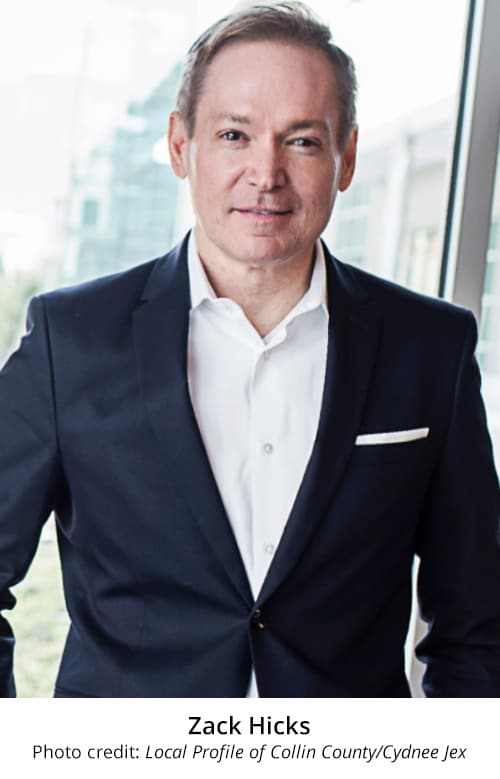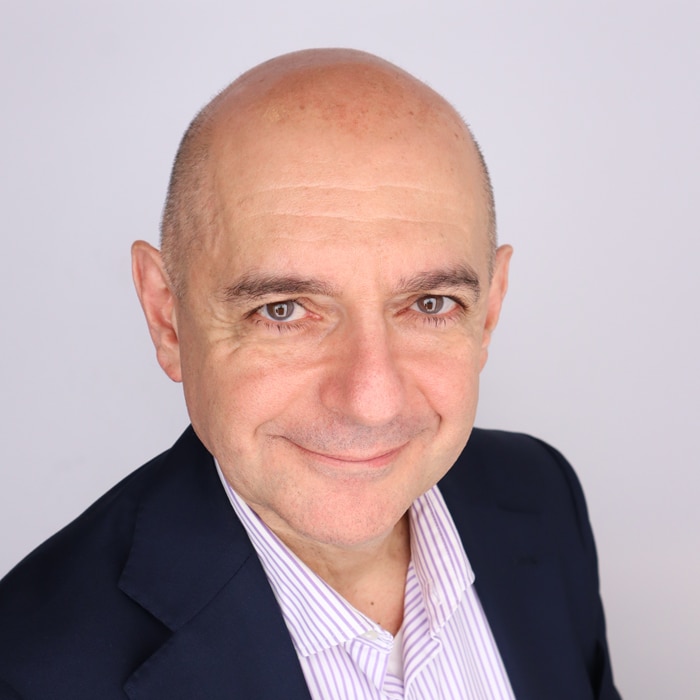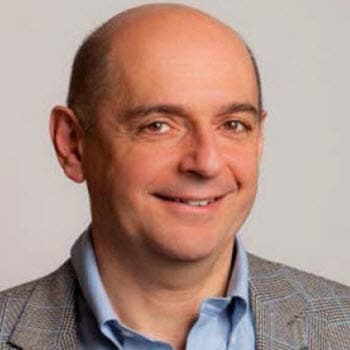
The paradox of Zack Hicks Lessons in ambidextrous leadership
14 minute read
30 July 2019
Sometimes, ambidextrous leadership means embodying multiple sets of seemingly contradictory traits. Here's how Zack Hicks, CEO of Toyota Connected, manages to pull it off.
Meet Zack Hicks
Meet Zack Hicks. Perhaps you haven’t heard of him yet, but he could be one of the most influential and interesting people in the automotive industry.
Learn more
Explore the Leadership collection
Subscribe to receive related content
Download the Deloitte Insights and Dow Jones app
When he’s not traveling the world, you might find him standing at his desk in a modest, transparent glass room in the corner of an open-plan office floor. The space features several low-slung lounge areas, four espresso machines, wine and beer on tap, and roaming millennials in jeans who enjoy perks such as free lunches, waffle Wednesdays, and unlimited paid time off. The day we1 first met Zack in person, we saw him hop directly from our conversation onto a stage in the middle of the office to take a mic and share his thoughts for “Brews and News” (a weekly office-wide knowledge-sharing gathering) while colleagues gathered around, drinking beer, and munching on pita chips and carrot sticks served with a giant bowl of hummus at the bar.

If this sounds like the scene at your average tech startup, it is, but it isn’t.
Zack is the founder, CEO, and president of Toyota Connected, a 200-person subsidiary of the Japanese automotive giant focused on transforming the mobility experience through innovative uses of data and technology. His company’s mission is the stuff of heady, transformational dreams: “Free us from the tyranny of technology, making a connected life a more human experience.”2 But CEO of Toyota Connected isn’t the only executive hat Zack wears. He’s also the chief digital officer (CDO) and executive vice president (EVP) for Toyota’s entire North American business—Toyota Motor North America (TMNA), employing over 36,000 people—where he is responsible for corporate IT. Though both are part of the same conglomerate, the startup atmosphere at Toyota Connected is worlds apart from TMNA’s more formal, corporate culture. Yet Zack manages to execute both roles, even physically going back and forth between Toyota Connected’s open workplace and the more formal corporate campus of TMNA just 1.5 miles away, seemingly without the need for the corporate code-switching you might expect.
Through it all, Zack stays Zack. Indeed, in a culture where it’s perhaps safest for employees to operate within certain corporate norms, Zack has unabashedly worked in ways that don’t fit the conventional mold. In his own words, he is not a “car guy” or a “technologist.” And yet he can be credited with reimagining Toyota as a digital-first business poised to transform the future of mobility. His aim is to prompt Toyota to disrupt itself, but to do so in a way that is not disruptive to how the company currently works. (In fact, a big part of his job at TMNA is to make sure that Toyota operates well today.)
Behind Zack’s ability to thrive in both roles is a core leadership attribute we call ambidexterity: the art of balancing operational optimization with innovative experimentation, simultaneously enhancing efficiency while cultivating continuous innovation. Of the five attributes our research has identified as integral to being an “undisruptable” CEO—emotional fortitude, a beginner’s mindset, a mastery of disruptive jiu-jitsu, deep knowledge of the customer, and ambidexterity—ambidexterity is perhaps the most critical, yet the most elusive.3 An ambidextrous mindset calls for leaders of large, legacy companies to embrace the kind of agile, intuitive behavior that has made freshly minted startups the darlings of digital consumers and investors, while also maintaining the operational excellence and discipline that many such incumbents are known for. This paradoxical ability can allow leaders to radically change the business model to remain relevant in the face of disruption in ways that their organizations can understand, accept, and integrate.
Zack Hicks personifies ambidextrous leadership in all its challenging complexity. On the surface, he appears to bring two completely different personas to each of his two jobs. As CDO of TMNA, he is charged with optimizing operations and maximizing efficiency; as CEO of Toyota Connected, he leads what is essentially an in-house startup that could eventually transform Toyota’s entire business model. Below the surface, however, lie a mindset and a leadership approach that make it possible for Zack to focus on both roles simultaneously and to cultivate—even relish—the personal and organizational tension necessary to do so.
What follows is based on conversations we had with Zack and several people who know him well. Our aim: to better understand his story and, in doing so, offer insights into the art of ambidexterity for other aspiring undisruptable leaders.
Living in the gaps
Zack doesn’t fit the typical Ivy League-educated corporate executive mold. Born in Melvindale, Michigan, he hails from a hardworking blue-collar family. He dropped out of college once and later went back to complete his undergraduate degree and his MBA. He doesn’t mince words, suffer fools, or trust consultants. He doesn’t volunteer much of anything about his personal life or even his personal ambitions, preferring to focus on Toyota. After a few conversations with him, you start to understand why: for Zack, personal ambitions are secondary to what customers need and want and how Toyota can succeed in delivering it. People have often commented on his remarkable confidence—but there is an underlying humility that at first seems so out of place that it could easily be mistaken for pretense by those who don’t yet know how driven he is to make things better.
Zack has never been afraid to do what he thinks should be done. Starting out in Toyota’s travel department in 1996, Zack remembers, “I had to create a report of people who took out-of-policy trips. They said we should take out the executives’ names. I said, No way—the same rules apply to everyone, so I left all the names in.”
He wasn’t yet even a manager when he made an appointment in 1997 with then-CIO Barbara Cooper to introduce himself as her travel department contact. “It was a little unusual,” Cooper says. Impressed, she became his mentor, pulled him into the IT department, and gave him his first project, which was to build an extranet for Toyota dealers. When it was done, Zack recalls, Cooper didn’t give him a pat on the back and say, “good job.” Instead, she said, “Let’s see if you can do that again—but without leaving so many dead bodies on the road.” It was an awakening for him. He had been easily frustrated by people with traditional, bureaucratic mindsets who seemed only to get in his way. Those who know him now praise his attentive listening skills and his ability to activate and empower people to not only voice their ideas, but also implement them by taking it upon himself to remove the obstacles in their way.
In his early years at Toyota, Zack remembers seeing “gaps” in the organization and realizing that those in authority were not doing anything to address them—a phenomenon that, when he sees it happening, frustrates him to this day. As he describes it: “People are doing the jobs they were hired to do yesterday, but those jobs are gone. We need them to do the job that exists today. If they’re not seeing what those opportunities are, they’re not empowering themselves and they’re not stepping into the gaps.”
“It’s the same thing with data,” he continues, speaking now of what galvanized him to set up Toyota Connected. “All this data is coming out of cars. I’m not the one who realized this. The whole world realized that there’s data coming out of cars. But building a company around it and doing something about it—well, if nobody else is going to do it, I’ll empower myself to step in.” It’s apparent that Zack didn’t set himself up as CEO of a new company for the glory or the prestige of the title, but because he saw a job that needed to be done and no one else was stepping up to do it.
This mindset drives everything Zack does at Toyota, where, as he puts it, “there’s no shortage of gaps.” The gaps are what energize and motivate him. And in launching Toyota Connected with a relatively small investment of US$5 million (“the other guy got US$1 billion,” he cracks, referring to the company’s establishment of Toyota Research Institute), he essentially created a home for himself in the gaps of the organization, amid the fault lines of Toyota’s tectonic plates. Whereas most people would try to run away from the uncertainty, volatility, and risk associated with such gaps, Zack seems irresistibly drawn to exploring their potential to move the very foundations of seemingly permanent edifices.
“By all rights I shouldn’t be the guy in this place today, coming in from outside a traditional automotive division, and outside of traditional IT,” Zack shares. “I think it’s just the fact that I stepped into these opportunities and empowered myself to deal with it.”
Ambidexterity in action
Zack made himself equally accountable—in an almost extreme way—for innovation as CEO of Toyota Connected on the one hand; and, as EVP and CDO of TMNA, for day-to-day execution and optimization on the other. His unique ability to manage the tension between exploration and exploitation has helped him become an ambidextrous leader in a massive organization with one of the world’s strongest historical legacies. What can other leaders learn from his experience?
1. Innovation’s prerequisite is operational excellence
While “information technology” has a very modern sound to it, it’s interesting to consider that IT is now the grown-up in the room. Toyota’s roots go back to 1891, originally as a hand loom factory, later as a sewing machine factory; the car company was founded in 1937. With such a long history, Toyota’s IT departments have in fact been part of the corporate fabric for several decades. Zack’s career path within Toyota’s IT tradition was unconventional, given where he started and his roles outside of IT along the way. Yet in the end, he acquired two decades of experience honing his execution skills. At the time that Zack submitted his proposal to found Toyota Connected, he had already been CIO for three years—the beginning of which included the major recall crisis of 2009. It’s hard to imagine that his proposal would have been approved had he not already proven himself multiple times over as an outstanding operator.
Pepperdine University Graziadio Business School professor Dr. John Mooney, who taught Zack in his course on "IT for Management," explains, “What significantly helps Zack go beyond operations is that he’s figured out how to build an organization that does operations well. It’s never a distraction for him.”
In a large incumbent organization, before being allowed to innovate and explore, you often have to earn the right to do so by proving yourself a credible, efficient, and effective operational executive on the existing playing field. Moreover, you may have to keep earning and re-earning this right. Zack describes the ongoing challenges of trying to talk about the future of Toyota with someone who might respond, “That’s great, but my HR system is down today.”
2. Disruption doesn’t have to be disruptive
Many incumbent organizations are not naturally open to external triggers for change, let alone internal ones. After all, they’ve typically grown and achieved success by doing something extraordinarily well, and often this means that they’ve doubled down on exploitation—refining and honing their operations to the nth degree. To practice ambidextrous leadership in this context requires a certain finesse. What is needed is to find ways to disrupt the business without being disruptive in the way you go about it.
This principle—to disrupt without being disruptive—applies just as strongly to an executive’s personal interactions with other leaders as it does to the broader company’s efforts to execute change while maintaining operational stability. Zack admits that he is seen as “aggressive” within Toyota’s prevailing cultural milieu. The very nature of his job, he says, requires “showing up in front of executives and EVPs and challenging them on the decisions they made, or holding up a mirror to senior leaders to lay out the real-life implications of what they want.” It plays to his advantage to be known as someone who will likely show up at one’s desk to ask “why” or “when.” At the same time, this behavior would never have been tolerated at Toyota if he were perceived as a bombastic, ego-driven personality. He’s known for not taking “no” as an answer, but he also knows that sometimes he can only push so far, and that incremental conciliation can help to win the longer game.
Zack seems to be antithetical to what Pepperdine’s Dr. Mooney describes as “big, loud CIOs who go around thumping on walls.” Instead, Zack has been able to prompt change while still giving colleagues and company leaders a reassuring sense of structure and stability. In his own words, he knows “how to talk to people in a way that makes mobility not scary, while creating a sense of urgency that the world is passing by.” In this, he draws on a fearlessness born out of the strength of his convictions: “I would rather go out swinging for the fences, doing the right thing for Toyota; I would rather get in trouble than not do the right thing,” he says.
3. Exploration doesn’t have to be inefficient
While ambidexterity is defined as the tension between optimization and operational efficiency on the one hand and exploration and experimentation on the other, that doesn’t mean that exploration has to be inefficient. On the contrary, for large legacy organizations, the most effective and acceptable means for experimentation is often low-key and economical. The relative modesty of the initial investment that he received to launch Toyota Connected turned out to be “the greatest gift,” Zack says, “because it gave me focus and set me on the right path.”
Zack seems to revel in a kind of scrappy purpose, infecting those around him with the belief that there is always a better and faster way. Barbara Cooper describes him as “an activator: someone who was immediately figuring out how to organize the energy he had at hand to achieve his goals. He was always optimizing and taking advantage of every moment, and never letting traditional barriers get in his way.”
Chris Tinto, Toyota’s former group vice president of mobility, concurs: “It’s not okay to take six months to make a decision. [Zack] wants it done in six days.” To support an agile, fail-fast environment, Zack has applied the concept of scrums to allow for flexible teams where people with specific skills can be cycled in and out of work sprints as needed—without the need to set up formal, hierarchical project teams.
4. Technology is the means, not the end
For any organization today, technology arguably drives both sides of ambidexterity. Yet Zack understands that technology is only a means to an end. Barbara Cooper remembers Zack’s instinct for “seeing the connection between technology and the end state of value. He was not a technologist, but he had an uncanny ability to know how the two play together, and then to make it happen.” Steve Basra, who works closely with Zack as EVP of Toyota Connected and vice president of Connected Technologies at TMNA, echoes: “People get so hung up on technology, [but] I’ve never heard Zack get caught up in technology. He’s always talking about how to build new business models, make the business better, and pull it forward into the new world. Technology is just a way to do it.”
Zack mobilizes other leaders at Toyota by engaging them in the ends: spelling out the future and giving them an approachable and visceral understanding of its implications, risks, and opportunities. “What I learned early as a leader,” he recalls, “is that talking about the future isn’t enough. It isn’t enough just to say, We’ve got this problem. We should be doing X. I had to tell the whole story and not assume that everybody could fill in the gaps on their own.” As an example, he says, “Everyone knows that the autonomous car is coming. But that’s not the same thing as sitting down with the service team and saying, ‘Do you realize that when we have all these sensors on a car, we’ll have to update each one over the air? How many people are going to be doing that?’ It’s about painting that picture of the army of people we’re going to need in this new future. When we’re releasing that car four years from now, what should we be investing in today? Those are the conversations that are more meaningful versus just saying, ‘Okay, well, we’re going to have an autonomous car for you.’”
As far as his own teams go, Zack is very intentional about using technology as an impetus for creative tension. “We have a lot of holy wars over technologies,” he says. “I like to create an environment that fosters [debate], but I don’t want it to overwhelm us. I want to create debate, but also nip it in the bud.” It’s a fine balance made possible by a culture of empathy—one reason that Zack established the weekly “Brews and News” sessions in the first place. “Half of the time, it’s [people] teaching each other. The other half is about the human side,” he says. “It’s about humanizing people by letting them share their favorite movie, for example, so someone will be seen for who they are, instead of as ‘the DevOps guy who isn’t letting me do what I want.’”
5. Exploitation and exploration can—and should—coexist
Effective ambidexterity is not about relegating experimentation to a secret, remote skunkworks project. Rather, it’s about meeting a personal and organizational both/and challenge—getting the two sides of ambidexterity to coexist.
For Zack and Toyota, the ultimate impact of ambidexterity comes in the commingling. On paper, Toyota Connected is a distinctly separate organization from the mother ship. And yet it has demonstrated itself to be a small but effective rudder that is influencing TMNA’s broader culture. According to Jack Hollis, group vice president and general manager of TMNA’s Toyota Division, the culture of agility and innovative thinking at Toyota Connected is now infusing TMNA. “The products and focus are separate. The questions being posed are separate. But the culture of how to solve them is being shared.”
Chris Tinto points to Zack’s personal influence as a big reason why: “He’s gotten people to see there’s a better, faster way to do things. He’s moved the ball around and said, ‘Look, we’ve got to do things differently as a company, because we’re competing with a startup with three guys in a basement, with no overhead, who can make [fast] decisions.’ He’s brought important technology changes to the company that might never have happened without him.”
Toward an undisruptable future
Toyota is famous for its kaizen culture of continuous improvement. What Zack is now arguably helping to promote in parallel is kaikaku, a lesser-known word that refers to radical change. Dr. Mooney says, “People talk about Toyota as having a strong culture of innovation. I think that’s true, but it’s historically been a culture of incremental innovation. We now know in hindsight, and Zack somehow knew in foresight, that Toyota was not going to get where it needed to go with incremental innovation. Zack made an organization that was world-renowned for innovation realize that what got them here was not going to get them where they needed to go. It took a lot of courage to make them realize that.”
It takes courage still. As Zack describes, “If we traditionally spend six years building a product, but technology cycles change every 18 months, how do we adapt? I spend most of my time engaged in these conversations.” Increasingly, other Toyota executives from branches outside North America have opted in as his followers and protégés. In the process of helping Toyota disrupt its own business model, it could also be that Zack is helping Toyota disrupt its own management and leadership model.
Toyota would now appear to have the best of both worlds. As one of the world’s top mobility companies, it has a mammoth global corporate footprint, with billions of dollars in sales and assets. And, for no more than an initial US$5 million investment, it now also boasts a lean, forward-thinking, in-house enclave of entrepreneurial energy that seeks to realize a vision for the future of connected, data-driven mobility—a vision that is inextricably linked to the company’s future.
As for Zack, he continues to be characteristically self-effacing. When we asked him about his personal ambitions, he brought the subject back to Toyota. “As I get older now, I worry about wanting to leave the company in a better place than I found it. I’ve been given this opportunity and feel a responsibility, as a leader, to help transform the company and get it ready for the next generation.”
Editor’s note: This article is based on research from Deloitte’s Chief Executive Program. Zack Hick’s participation in this article is solely for educational purposes based on his knowledge of the subject, and the views expressed by him are solely his own. This article should not be deemed or construed to be for the purpose of soliciting business for Toyota Motor Company or Toyota Connected, nor does Deloitte advocate or endorse the services or products provided by Toyota Motor Company or Toyota Connected.
Required reading for the C-suite
-
Seven steps to a more strategic board: What CEOs need to know Article5 years ago
-
Disruptive jiu-jitsu Article6 years ago
-
A beginner’s mindset Article6 years ago
-
Building business resilience to the next economic slowdown Article6 years ago
-
The tech-savvy board Article5 years ago
-
Executive transitions Collection













